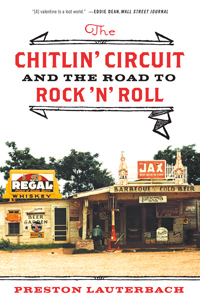Louis Jordan
Born July 8, 1908, Brinkley, Arkansas
Died February 4, 1975, Los Angeles, California
Circuit active: 1942-1959
Louis Jordan is one of the more grossly misunderstood artists in American music. Not that he’s overlooked. He is in the Rock ‘n’ Roll Hall of Fame. It’s that the writers of music history describe him either as a novelty act—many of his lyrics are clever or funny, and all are delivered silvery smooth—or an exponent of the fictitious genre jump blues. Let’s get this straight: Louis Jordan was the key figure in the transformation of American pop from big band swing to small band rock ‘n’ roll.
That’s not to claim he was the first rock ‘n’ roll artist, but more of a big bang in the black music universe. In a time where big bands ruled, and people came out to hear featured instrumental soloists, Jordan and his Tympany Five did things in a new way, coming on strong with hit recordings in late 1941 and a breakthrough chitlin’ circuit tour in 1942. Veteran circuit performer “Gatemouth” Moore explained Jordan’ revolutionary effect: “He could play just as good and just as loud with five [pieces] as [other bands were with] 17. And it was cheaper.”
Promoters, club owners, and patrons all loved that last part. During World War II, there was a nightclub boom in black America, as total employment led to unprecedented amounts of leisure cash. After the war, though, the booming black economy busted. Owners of the new nightclubs needed to make their ventures work. Fortunately for them, the Jordan fad had caught on. Not only did he play with a loud, ballsy combo rather than full orchestra, Jordan made the vocalist, himself, the main draw.
As “Gatemouth” Moore noted, this adaptation was every bit as revolutionary as Jordan’s small band configuration. “With the bands in the ’30s, the singer was like the porter. The singer set up the bandstand. He wasn’t the attraction in those days. But it done changed.”
Following twenty years of big band, the audience embraced the new sound, and for black music businessmen, the numbers worked. Louis Jordan’s fee, at least on his first tour, was $350, while Louis Armstrong’s was $1500. Throughout the war years and into 1946, Jordan had six #1 hits. None of his dozen 1946 releases peaked below #3 on the black music charts. The revolution was on. Small bands like Joe Liggins and the Honeydrippers and Johnny Moore and the Three Blazes followed Jordan’s small band-blues heavy blueprint to hit status.
By the end of the 1940s, numerous black big bands had died, swing was relegated to nostalgia, and the new sound had taken over the black music business. Billboard recognized as much, renaming its popular black record list the Rhythm and Blues chart. A new generation of singers stormed the scene, and Fats Domino, B.B. King, Little Richard, and James Brown all said Louis Jordan was their inspiration.
Just before his death in 1975, Jordan told historian Arnold Shaw, “I’d like to say one thing. Rock ‘n’ roll was not a marriage of rhythm and blues [to] country and western. That’s white publicity. Rock ‘n’ roll was just a white imitation, a white adaptation, of Negro rhythm and blues.”


